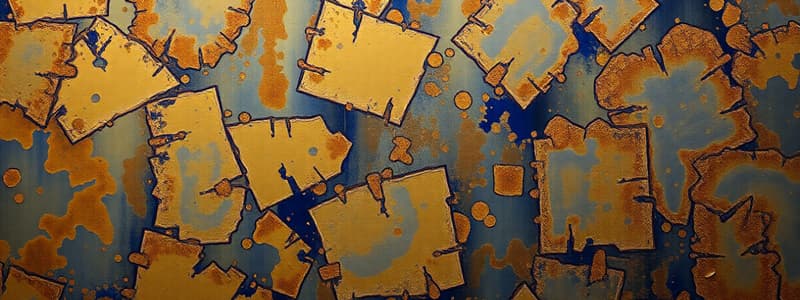Podcast
Questions and Answers
What is corrosion and what common environmental factors contribute to this process?
What is corrosion and what common environmental factors contribute to this process?
Corrosion is the deterioration of a material due to a chemical reaction with its environment, primarily triggered by moisture, oxygen, and acidic or basic solutions.
What is the purpose of protective coatings in corrosion prevention?
What is the purpose of protective coatings in corrosion prevention?
To prevent direct exposure of the material to the corrosive environment.
Explain the roles of anodic and cathodic reactions in the electrochemical process of corrosion.
Explain the roles of anodic and cathodic reactions in the electrochemical process of corrosion.
Anodic reactions involve the oxidation of a metal which releases electrons, while cathodic reactions involve the reduction of oxygen or other species that consume these electrons.
How does cathodic protection help in reducing corrosion?
How does cathodic protection help in reducing corrosion?
Identify the factors that can influence the rate of corrosion in metals.
Identify the factors that can influence the rate of corrosion in metals.
What role does monitoring and inspection play in corrosion management?
What role does monitoring and inspection play in corrosion management?
What is galvanic corrosion, and how does it occur?
What is galvanic corrosion, and how does it occur?
Describe one type of corrosion and its specific cause.
Describe one type of corrosion and its specific cause.
Describe pitting corrosion and its characteristics.
Describe pitting corrosion and its characteristics.
What is the function of corrosion inhibitors?
What is the function of corrosion inhibitors?
What defines crevice corrosion and where does it typically occur?
What defines crevice corrosion and where does it typically occur?
What is the significance of selecting appropriate materials in corrosion prevention?
What is the significance of selecting appropriate materials in corrosion prevention?
How does stress corrosion cracking differ from uniform corrosion?
How does stress corrosion cracking differ from uniform corrosion?
What method would you use for accelerated corrosion testing?
What method would you use for accelerated corrosion testing?
What role do impurities have in influencing the corrosion rate of metals?
What role do impurities have in influencing the corrosion rate of metals?
What are the economic impacts of corrosion?
What are the economic impacts of corrosion?
How does encapsulation contribute to corrosion control?
How does encapsulation contribute to corrosion control?
Name one specialized technique used in corrosion testing.
Name one specialized technique used in corrosion testing.
Flashcards
Corrosion
Corrosion
The process by which a material deteriorates due to chemical reactions with its surrounding environment.
Oxidation
Oxidation
A chemical reaction where a metal loses electrons, typically in the presence of oxygen, water, and electrolytes.
Electrochemical Corrosion
Electrochemical Corrosion
An electrochemical process where a metal corrodes due to the transfer of electrons between anodic and cathodic reactions.
Anode
Anode
Signup and view all the flashcards
Cathode
Cathode
Signup and view all the flashcards
Galvanic Corrosion
Galvanic Corrosion
Signup and view all the flashcards
Pitting Corrosion
Pitting Corrosion
Signup and view all the flashcards
Crevice Corrosion
Crevice Corrosion
Signup and view all the flashcards
Protective Coatings
Protective Coatings
Signup and view all the flashcards
Alloying
Alloying
Signup and view all the flashcards
Cathodic Protection
Cathodic Protection
Signup and view all the flashcards
Atmospheric Corrosion
Atmospheric Corrosion
Signup and view all the flashcards
Water Corrosion
Water Corrosion
Signup and view all the flashcards
Soil Corrosion
Soil Corrosion
Signup and view all the flashcards
Biological Corrosion
Biological Corrosion
Signup and view all the flashcards
Corrosion Inhibitors
Corrosion Inhibitors
Signup and view all the flashcards
Maintenance and Inspection
Maintenance and Inspection
Signup and view all the flashcards
Selection of Appropriate Materials
Selection of Appropriate Materials
Signup and view all the flashcards
Study Notes
Introduction to Corrosion
- Corrosion is the deterioration of a material by chemical reaction with its environment.
- This process typically involves oxidation, where a metal loses electrons.
- Common environments triggering corrosion include moisture, oxygen, and acidic/basic solutions.
- Corrosion can affect infrastructure, machinery, and various materials, leading to significant economic losses.
- Understanding and mitigating corrosion is crucial in various industries.
Electrochemical Aspects of Corrosion
- Corrosion is essentially an electrochemical process, usually involving anodic and cathodic reactions.
- Anodic reactions involve the oxidation of a metal, releasing electrons into the solution.
- Cathodic reactions involve the reduction of oxygen or other species, consuming electrons.
- The electrochemical cell formed allows for the transfer of electrons and ionic conduction between anodes and cathodes.
- The rate of corrosion depends on factors like the electrolyte composition, the nature of the metal, and the availability of oxygen.
Factors Affecting Corrosion
- Material characteristics: Different metals possess varying susceptibility to corrosion due to their inherent properties, like their electrochemical potential.
- Environmental factors: The presence of moisture, oxygen, electrolytes, pH, and temperature significantly influence the corrosion rate.
- Design aspects: The design of a material can affect its susceptibility to corrosion and how it protects itself.
- Presence of impurities: Impurities in a metal can influence its reactivity to environmental factors and promote corrosion.
- Stray currents: Exposure to external stray currents can accelerate corrosion.
Corrosion Mechanisms
- Galvanic corrosion: Occurs when two dissimilar metals are in contact in an electrolyte, creating a galvanic cell.
- Pitting corrosion: Localized corrosion that forms small pits or holes in a metal surface.
- Crevice corrosion: Occurs in confined areas (crevices) where oxygen is restricted.
- Uniform corrosion: The uniform attack of a metal surface.
- Stress corrosion cracking: Corrosion aided by tensile stress that may result in cracking of the material.
- Erosion-corrosion: The combined action of corrosive and erosive environments causes faster deterioration of a material.
Corrosion Prevention Methods
- Protective coatings: Applying coatings like paints, polymers, or metals to prevent direct exposure of the material to the corrosive environment.
- Alloying: Creating alloys with improved corrosion resistance by combining different metals.
- Cathodic protection: Providing an external current to reduce the corrosion rate by making the material the cathode of an electrochemical cell.
- Design modifications: Changing material geometry to minimize crevices or areas prone to corrosion.
- Proper selection of materials: Choosing materials with superior corrosion resistance for the specific environment.
- Monitoring and Inspection: Regular monitoring of systems and components susceptible to corrosion plays a large role in managing corrosion and preventing failures by early detection.
Types of Corrosion
- Atmospheric corrosion: Corrosion that occurs from exposure to the atmosphere, moisture, and other environmental factors.
- Water corrosion: Corrosion from exposure to water, including rain, rivers, and seawater.
- Soil corrosion: Corrosion of buried metal components in the ground.
- Biological corrosion: Corrosion caused by microorganisms.
Corrosion Control Strategies
- Corrosion inhibitors: Addition of compounds to the environment to reduce corrosion.
- Protective coatings: Application of paints, polymers, or metals for protection.
- Cathodic protection: Use of sacrificial anodes or impressed currents to make the metal the cathode of an electrochemical cell.
- Selection of appropriate materials: Choose materials that are less susceptible to corrosion in the particular environment.
- Encapsulation: Embedding materials in protective materials.
- Maintenance and inspection: Regular maintenance and inspection of structures to detect and address corrosion issues early.
Corrosion Testing Methods
- Weight loss measurements: Measuring the amount of metal lost over time.
- Electrochemical methods: Using electrochemical techniques to study corrosion processes.
- Accelerated corrosion tests: Using conditions to accelerate the corrosion process for faster testing.
- Visual inspections: Identifying signs of corrosion through visual examinations.
- Specialized techniques: Advanced microscopy and advanced techniques may be used for specific materials and environments.
Impact of Corrosion
- Economic losses from infrastructure damage, maintenance, replacement, etc.
- Environmental pollution caused by corrosion products.
- Health issues related to corrosion exposure.
- Safety hazards stemming from corroded structures or equipment.
Conclusion
- Corrosion is a significant issue that affects many aspects of modern life.
- Understanding corrosion mechanisms, factors, and prevention methods is crucial for maintaining infrastructure and equipment.
- Ongoing research and development are essential for the development of new materials and technologies to combat corrosion.
Studying That Suits You
Use AI to generate personalized quizzes and flashcards to suit your learning preferences.




